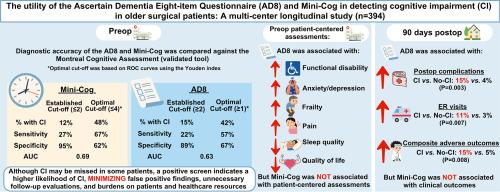The utility of the Ascertain Dementia Eight-item Questionnaire (AD8) and Mini-Cog in detecting cognitive impairment in older surgical patients – The Detect CI study
IF 5.1
2区 医学
Q1 ANESTHESIOLOGY
引用次数: 0
Abstract
Background
Brain health is often overlooked before surgery, missing an opportunity to identify at-risk patients. This study aimed to (1) examine the diagnostic performance of two ultra-rapid cognitive screening tools, the Ascertain Dementia Eight-item Questionnaire (AD8) and Mini-Cog, against a tool validated in surgical populations, the Montreal Cognitive Assessment (MoCA); and (2) compare preoperative patient-centered assessments and postoperative outcomes between those with and without cognitive impairment (CI).
Methods
CI was classified by scoring ≥2 on the AD8, ≤2 on the Mini-Cog, and/or ≤25 on the MoCA in non-cardiac patients ≥65 years old.
Results
Of 394 participants, 35 % had preoperative CI on the MoCA, 15 % on the AD8, and 12 % on the Mini-Cog. Both the AD8 and Mini-Cog demonstrated moderate area under the curve, with superior specificity over sensitivity. In contrast to the Mini-Cog, participants with CI on the MoCA and AD8 reported poorer preoperative patient-centered assessments than those without. Specifically, the AD8 was associated with poorer functional disability, frailty, anxiety and/or depression, pain level, sleep quality, and quality of life. Contrary to the MoCA and Mini-Cog, CI on the AD8 was associated with higher all-cause complications (15.1 % vs. 3.7 %, P = 0.003), emergency department visits (11.3 % vs. 2.5 %, P = 0.007), and composite adverse outcomes (15.1 % vs. 4.6 %, P = 0.008) at 90 days.
Conclusions
Although the AD8 and Mini-Cog demonstrated comparable diagnostic accuracy for CI, the AD8 provided additional insights into preoperative patient-centered assessments and 90-day adverse outcomes. Our study emphasizes the importance of preoperative screening for CI, highlighting the AD8 as a valuable tool.

确定痴呆八项问卷(AD8)和Mini-Cog在老年外科患者认知障碍检测中的应用——Detect CI研究
手术前往往忽视大脑健康,错失了识别高危患者的机会。本研究旨在(1)检验两种超快速认知筛查工具的诊断性能,确定痴呆八项问卷(AD8)和Mini-Cog,与手术人群中验证的工具蒙特利尔认知评估(MoCA);(2)比较有和无认知障碍(CI)患者的术前以患者为中心的评估和术后结果。方法在年龄≥65岁的非心脏患者中,以AD8评分≥2分、Mini-Cog评分≤2分、MoCA评分≤25分对sci进行分类。结果394名参与者中,术前MoCA CI为35%,AD8 CI为15%,Mini-Cog CI为12%。AD8和Mini-Cog曲线下面积适中,特异性优于敏感性。与Mini-Cog相比,MoCA和AD8上CI的参与者报告的术前以患者为中心的评估较差。具体来说,AD8与较差的功能障碍、虚弱、焦虑和/或抑郁、疼痛水平、睡眠质量和生活质量有关。与MoCA和Mini-Cog相反,90天时,AD8的CI与较高的全因并发症(15.1%对3.7%,P = 0.003)、急诊就诊(11.3%对2.5%,P = 0.007)和综合不良结局(15.1%对4.6%,P = 0.008)相关。结论:虽然AD8和Mini-Cog对CI的诊断准确性相当,但AD8为术前以患者为中心的评估和90天不良结局提供了额外的见解。我们的研究强调术前CI筛查的重要性,强调AD8是一个有价值的工具。
本文章由计算机程序翻译,如有差异,请以英文原文为准。
求助全文
约1分钟内获得全文
求助全文
来源期刊
CiteScore
7.40
自引率
4.50%
发文量
346
审稿时长
23 days
期刊介绍:
The Journal of Clinical Anesthesia (JCA) addresses all aspects of anesthesia practice, including anesthetic administration, pharmacokinetics, preoperative and postoperative considerations, coexisting disease and other complicating factors, cost issues, and similar concerns anesthesiologists contend with daily. Exceptionally high standards of presentation and accuracy are maintained.
The core of the journal is original contributions on subjects relevant to clinical practice, and rigorously peer-reviewed. Highly respected international experts have joined together to form the Editorial Board, sharing their years of experience and clinical expertise. Specialized section editors cover the various subspecialties within the field. To keep your practical clinical skills current, the journal bridges the gap between the laboratory and the clinical practice of anesthesiology and critical care to clarify how new insights can improve daily practice.

 求助内容:
求助内容: 应助结果提醒方式:
应助结果提醒方式:


